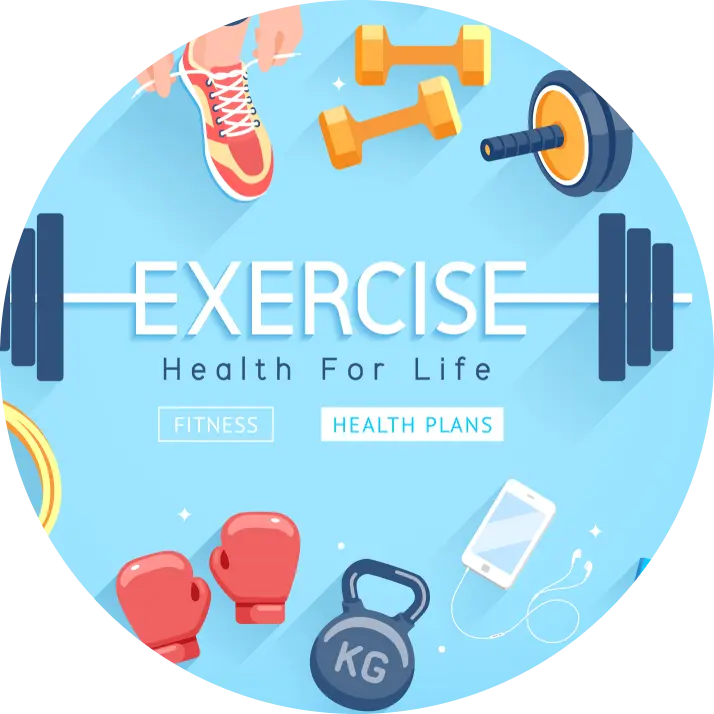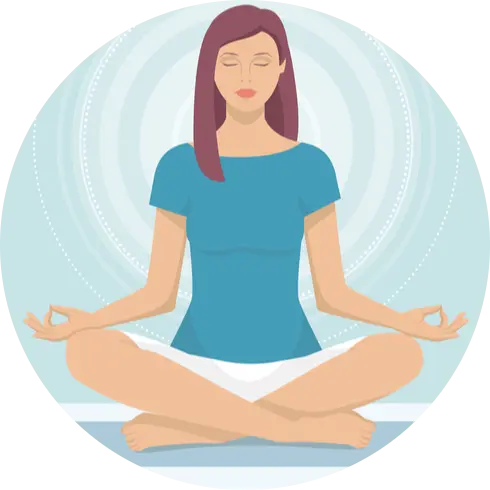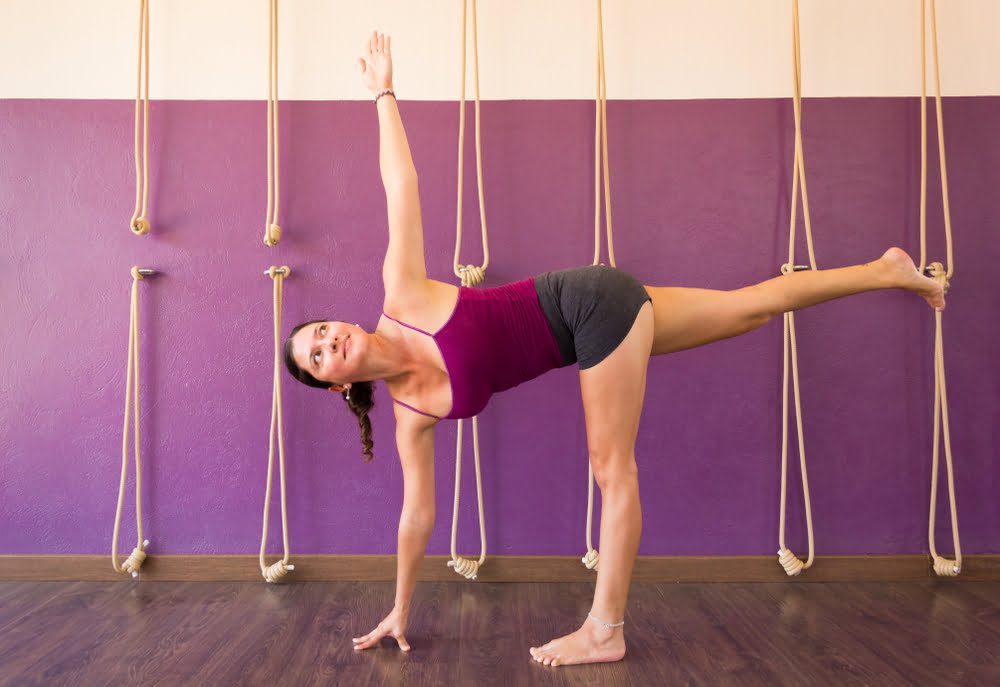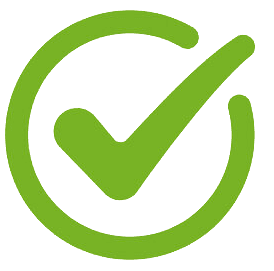Revolved Half Moon Yoga Poses, also known as Parivrtta Ardha Chandrasana in Sanskrit, are a dynamic and challenging sequence of asanas (postures) that bring a twist to the traditional Half Moon Pose. These poses require balance, strength, and flexibility, making them an excellent workout for the mind, body, and spirit.
In this article, we will explore the variations of Revolved Half Moon Yoga Poses, their benefits, and how to practice them safely and effectively. Whether you are a beginner or an experienced yogi looking to deepen your practice, these variations will provide a fresh perspective and take your yoga journey to new heights. So, let’s dive in and discover the transformative power of Revolved Half Moon Yoga Poses!
Benefits of Revolved Half Moon Yoga Pose.
1. Enhances core strength.
Performing the revolved half moon pose requires engaging the core muscles to maintain balance and stability. Regular practice of this pose strengthens the abdominal muscles, obliques, and lower back, leading to improved core strength and stability in daily activities.
2. Increases lower body strength.
This pose targets and strengthens the muscles in the legs, including the quadriceps, hamstrings, glutes, and calves. As these muscles work to support the body in this challenging balance, they grow stronger, enhancing overall lower body strength.
3. Improves balance and stability.
Maintaining balance in the revolved half moon pose is a constant challenge, requiring focus and concentration. Regular practice helps to improve proprioception and spatial awareness, enhancing overall balance and stability both on and off the mat.
4. Enhances flexibility.
The revolved half moon pose stretches and lengthens the muscles in the hips, hamstrings, and spine. Regular practice helps to increase flexibility in these areas, improving overall range of motion and preventing injuries in daily activities.
5. Stimulates digestion and detoxification.
The twisting motion involved in the revolved half moon pose stimulates the digestive organs, enhancing digestion and metabolism. It also aids in detoxification by improving circulation and promoting the elimination of toxins from the body.
6. Increases mental focus and concentration.
Balancing in the revolved half moon pose requires mental clarity and concentration. Regular practice helps to improve focus, sharpen the mind, and cultivate a sense of presence, which can be carried into daily life off the mat.
7. Relieves stress and anxiety.
Engaging in the revolved half moon pose activates the parasympathetic nervous system, promoting relaxation and reducing stress and anxiety. The deep breathing and meditative aspects of this pose can help calm the mind and bring a sense of tranquility.
8. Improves posture and spinal alignment.
Performing the revolved half moon pose helps to improve posture by lengthening the spine and opening the chest. Regular practice can counteract the negative effects of prolonged sitting or poor posture, promoting a more aligned and upright posture.
9. Cultivates body awareness.
The revolved half moon pose encourages a deep connection with the body, as it requires precise alignment and constant adjustments for balance. Practicing this pose regularly helps to cultivate body awareness, allowing for better understanding and control of one’s body in various physical activities.
10. Builds self-confidence.
Successfully mastering the revolved half moon pose can boost self-confidence and self-esteem. As practitioners progress in their practice and witness their own growth, they become more self-assured and empowered, both on and off the mat.
| 💡 Tips FitnessQuora.com Incorporating the revolved half moon yoga pose into your practice can bring about a myriad of physical, mental, and emotional benefits. Whether you are a beginner or an advanced yogi, this pose offers a fulfilling challenge that can transform your overall well-being. So, roll out your mat, embrace the pose, and reap the multitude of rewards it has to offer. |
How to do Revolved Half Moon Yoga Pose?
Here’s a step-by-step guide on how to perform this pose:
1. Begin in a standing position at the top of your mat, with your feet hip-width apart and arms relaxed by your sides.
2. Take a deep inhale, grounding yourself into the mat, and as you exhale, engage your core and shift your weight onto your right foot.
3. Slowly raise your left leg behind you, keeping it straight and parallel to the mat. Flex your left foot, pointing your toes towards the floor.
4. Simultaneously, hinge forward at your hips, bringing your torso parallel to the mat. Keep your spine long and your gaze focused on the floor to maintain balance.
5. Extend your arms out in front of you and parallel to the mat, palms facing each other.
6. As you inhale, twist your torso to the right, bringing your left hand down to the mat or a block on the outside of your right foot.
7. Reach your right arm up towards the sky, extending it straight above your shoulder. Ensure that your shoulder is stacked directly on top of your right wrist.
8. Engage your core muscles and lengthen your spine, creating a straight line from the crown of your head to your left heel.
9. Gently rotate your gaze upward, directing your vision towards your right fingertips. Maintain this position for a few breaths, allowing your body to settle into the pose.
10. To release the pose, slowly lower your right hand down to the mat or block, and with control, bring your left leg back to the starting position.
11. Take a moment to rest and reset before repeating the pose on the opposite side.
| 💡 Tips FitnessQuora.com Remember, it’s important to listen to your body and modify the pose as needed. If reaching the floor is challenging, you can place your hand on a block or prop for support. With consistent practice and patience, you’ll gradually build strength, flexibility, and balance, ultimately achieving the Revolved Half Moon Yoga Pose with ease. |
Top 10 Variations of Revolved Half Moon Yoga Pose and How To Do?
While the basic form of Revolved Half Moon is the same, there are various variations that can be incorporated to deepen the practice and explore different aspects of the pose. Here are the top 10 variations of Revolved Half Moon yoga pose and how to do them:
1. Bound Revolved Half Moon.
Begin in Revolved Half Moon pose and reach the top arm under the body, threading it through the space between the standing leg and the mat. Clasp the hands together behind the back, deepening the twist and opening the shoulders.
2. Revolved Half Moon with a Block.
Place a yoga block on the ground in front of the standing foot. From Revolved Half Moon, reach the top arm towards the sky and place the hand on the block. This modification provides additional support and stability, allowing for a deeper twist.
3. Revolved Half Moon with a Strap.
Use a yoga strap to bind the top arm behind the back in Revolved Half Moon pose. This variation helps to increase shoulder flexibility and allows for a deeper twist.
4. Revolved Half Moon with a Wall.
Practice Revolved Half Moon with the support of a wall. Place the fingertips of the top hand on the wall, using it as a guide and support to deepen the twist and maintain balance.
| 💡 Tips FitnessQuora.com Remember to always warm up the body before attempting these variations and to listen to your body’s limits. With regular practice and patience, these variations of Revolved Half Moon pose can help you deepen your practice, enhance your balance, and explore new aspects of this invigorating pose. |
Who can Practice Variations of Revolved Half Moon Yoga Pose?
Anyone who has a basic understanding of yoga and is looking to challenge their balance and flexibility can practice variations of the Revolved Half Moon Yoga Pose. This pose requires a strong core and stability, making it suitable for intermediate to advanced yogis.
However, beginners can also practice simpler variations by using props such as blocks or a wall for support. It is important to listen to your body and modify the pose according to your level of comfort and flexibility.
Bottom Line.
Variations of the Revolved Half Moon yoga pose offer a multitude of benefits for both the mind and body. These variations provide a deeper stretch, increased flexibility, improved balance, and enhanced core strength. They also offer opportunities for practitioners of all levels to challenge themselves and progress in their yoga practice. Whether it’s the Revolved Half Moon with a bound hand or the Revolved Half Moon with a leg lifted, each variation allows individuals to explore their own body’s capabilities and find a sense of alignment, stability, and focus. By incorporating these variations into our yoga routine, we can experience increased energy, improved posture, and a greater sense of overall well-being. So, let’s embrace the variations of Revolved Half Moon poses and continue to explore the endless possibilities that yoga has to offer.

 Workout
Workout
 Meditation
Meditation





 Contact Us
Contact Us





